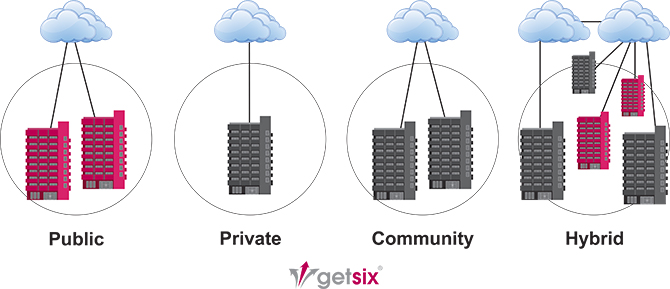According to the different delivery models:
In general, several delivery models exist for ‘Cloud Computing’.
- On Premise;
- Co-location;
- Hosting;
- Infrastructure-as-a-Service (IaaS);
- Platform-as-a-Service (PaaS);
- Software-as-a-Service (SaaS);
- Business-Process-as-a-Service (BPaaS).

The main things that are effected by each of these types of cloud computing is:
- Flexibility;
- Control;
- Management simplicity;
- Vendor lock in.
On-Premise:
This option is great where companies/businesses who want to ensure that they have full control over their data, along with complete flexibility to configure their Cloud, exactly how you want it to work. You control all the hardware, network, environment, etc. to do with your Cloud setup. This ensures you don’t rely on 3rd parties with your data, if this is something you would prefer not to do. On premise could be the most expensive option, as you don’t get to take advantage of economies of scale that a Cloud provider can take advantage of. You may need to buy a cluster of extra capacity you won’t be using, and you will need the expertise in house to manage the Cloud.
Flexibility: High
Control: High
Management Simplicity: Low
Vendor Lock In: Low
IaaS:
Infrastructure-as-a-Service is renting the infrastructure to run your own application and OS. It gives reasonable control, with flexibility over your infrastructure for reduced complexity and management costs. While there is not direct control over the underlying hardware, network, or virtualisation you still have the ability to install, manage your own OS and the applications running on the infrastructure.
Flexibility: Medium
Control: Medium
Management Simplicity: Medium
Vendor Lock In: Medium
PaaS:
Platform-as-a-Service allows you to host your own custom application, where the provider handles everything for you except your application and your data, they provide the infrastructure, OS and services required to run your application. PaaS is great if you have an application developed for the specific PaaS platform, and means you don’t have to worry about hardware, network, or managing the OS, and underlying software to run your application. You can focus on the development of your application and easily scale as you require additional resources.
Flexibility: Low
Control: Low
Management Simplicity: High
Vendor Lock In: High
SaaS:
Software-as-a-Service is where the entire application is provided to you in a hosted format, you don’t need to worry about running anything below the application, such as the infrastructure, OS, services, etc. This is the easiest to manage in terms of management, however the least flexible.
Flexibility: Very Low
Control: Very Low
Management Simplicity: Very High
Vendor Lock In: Extremely High
BPaaS:
Business-Process-as-a-Service (BPaaS) is any type of horizontal or vertical business process that’s delivered based on the Cloud services model. These Cloud services – which include Software-a-as-Service (SaaS), Platform-as-a-Service (PaaS) and Infrastructure-as-a-Service (IaaS) – are therefore dependent on related services.
The following characteristics define BPaaS:
- The BPaaS sits on top of the other three foundational Cloud services: SaaS, PaaS and IaaS;
- A BPaaS service is configurable based on the process being designed;
- A BPaaS service must have well-defined APIs, so it can be easily connected to related services;
- A BPaaS must be able to support multiple languages and multiple deployment environments because a business cannot predict how a business process will be leveraged in the future;
- A BPaaS environment must be able to handle massive scaling. The service must be able to go from managing a few processes for a couple of customers to being able to support hundreds, if not thousands of customers and processes. The service accomplishes that objective by optimising the underlying Cloud services to support this type of elasticity and scaling.
According the different Cloud Computing Services and how they could be used:

According the responsibilities:
What are the Cloud customer’s responsibilities, and what are the Cloud provider’s responsibility?
This is probably the most important questions you should be asking yourself and your Cloud provider when researching options. It’s quite important to understand this as it could result in significant downtime or loss of data. For example in IaaS (Infrastructure-as-a-Service) the responsibility of the actual data stored on the virtual servers provided to you are your own responsibility, and if you are hacked you are responsible for restoring your backups. However on a SaaS (Software-as-a-Service) the responsibility is usually with the cloud provider for your data, and ensuring your data is safe from hackers.
Where your data is stored is also an important one, is the jurisdiction of where your data suitable for your business? Is the location a safe location? In a trusted data centre?
ere is a diagram of where the responsibility typically lies with the types of ‘Cloud Computing’:

According the deployment models
The Clouds also have several deployment models:
- Private: The Cloud infrastructure is operated solely for one organisation. This does not imply that it is managed or located within the same organisation – in fact, it can be managed by a 3rd party and located elsewhere;
- Community: The Cloud infrastructure is shared by several organisations, which share common concerns;
- Public: The Cloud infrastructure is made available to the general public, and is own by an organisation selling Cloud services;
- Hybrid: The Cloud infrastructure is a composition of two or more deployment models above.
















